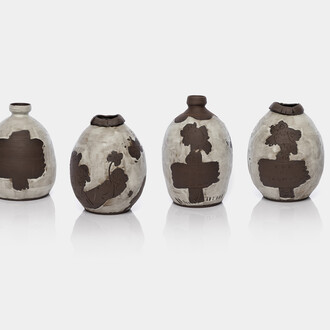Featuring 28 prints from the Museum’s collection, including several designs that are the only known impression, Suzuki Harunobu and the Culture of Color offers a rare opportunity to see a rich assembly of work by one of the most celebrated artists in the history of the Japanese print. A painter and print designer, Suzuki Harunobu (1725?–1770) drew his subject matter not only from the urban entertainments of the city of Edo—what was known in his day as ukiyo-e, “pictures of the floating world”—but also from the classical poetry of China and Japan and scenes of everyday life. Harunobu’s imagery often conveys amusing subtexts that appealed especially to the cognoscenti of his day, but it was the striking color of his prints that drove his success at a critical moment in Japanese printmaking—and that has shaped his legacy ever since.
From about 1765 until his death in 1770, Harunobu dominated the field of full-color prints. Replacing the earlier prints of limited color palette, this technique used five or more woodblocks for each impression. The resulting prints were called “brocade pictures” (nishiki-e), a period term that nods to their sumptuous quality. The earliest single-sheet prints in the full-color technique were private commissions, made for wealthy aesthetes who exchanged them as gifts during the New Year celebrations of 1765 and 1766. Recognizing the appeal of these deluxe objects, Edo publishers quickly adopted the full-color printing technique for commercial use. Working collaboratively with publishers, patrons, carvers, and printers, Harunobu is estimated to have produced as many as 800 distinct print designs in the span of just five years. These nishiki-e transformed the publishing industry for single-sheet prints in Edo. After Harunobu’s career, the culture of color—increasingly saturated, sophisticated, and technically superb—became a fundamental characteristic of Japanese prints.
This exhibition investigates Harunobu’s contributions to the culture of color, as well as our perceptions of his legacy. Critics have long praised the pale, evanescent palette of Harunobu’s prints as evidence of a refined artistic sensibility. However, recent research has shown that his prints originally featured far more saturated, vivid hues, which have been lost over time. The pigments and dyes used in the early years of nishiki-e are highly sensitive to light and moisture. Certain plant-derived organic colorants not only fade, but transmute to another hue entirely. The fresh perspectives on Harunobu’s color offered in this exhibition incorporate the first fruits of an ongoing collaboration, funded by the Andrew W. Mellon Foundation, between Dr. Tami Lasseter Clare, Associate Professor of Chemistry at Portland State University; Museum Conservator Samantha Springer; and Curator Dr. Jeannie Kenmotsu.
After the close of this exhibition, the prints will rest in the Museum vault for several years. However, thanks to a generous grant from the Institute of Museum and Library Services, the Portland Art Museum is currently engaged in a multi-year project to photograph, digitize, and re-catalogue the entire Japanese print collection, making it accessible online for audiences worldwide.
















